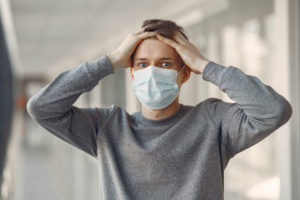 By definition, panic attacks strike suddenly and without warning. Many times panic attacks occur when we’re just hanging out with friends, we’re in class or even asleep in bed. Symptoms usually peak quickly and sufferers often report feeling worn out afterwards.
By definition, panic attacks strike suddenly and without warning. Many times panic attacks occur when we’re just hanging out with friends, we’re in class or even asleep in bed. Symptoms usually peak quickly and sufferers often report feeling worn out afterwards.
Some common symptoms include:
- Sense of dread
- Fear of loss of control, not being able to breath or even dying
- Pounding heart rate
- Sweating
- Slight shaking
- Shortness of breath or tightness in your chest or throat
- Chills/Hot flashes
- Nausea/Abdominal cramping
- Chest pain almost like heartburn
- Headache
- Dizziness, lightheadedness or faintness
- Numbness or tingling sensation especially on extremities, face, or, head
- Feeling disoriented
As important as it is to understand what a panic attack is, it’s also important to understand what it isn’t.
A panic attack doesn’t last more than an hour with most lasting less than 20 minutes. Often, when I hear college students talk about having a panic attack, what most of them are actually saying is they feel overwhelmed and stressed out. They are not having a panic attack. There is no single, acute event. Feeling anxious about that paper due Sunday night is not a panic attack. Not getting an internship and stressing about it is not the same as a panic attack. Much of the language college students use isn’t nuanced enough to differentiate between anxiety, stress and a panic attack.
What can parents do?
Don’t try to convince them it’s not a panic attack. Do validate they feel stressed.
Don’t freak out and get on the first flight to see them. Do keep talking with them and ask them how you can best support them.
Don’t try to solve any of the stressors (eg. ‘Why not just get the paper finished and turn it in!?’). Do acknowledge they have stuff they need to get done but it can wait until they feel more in control and prepared to work.
The next thing parents can do is insist on starting treatment with a therapist. A good therapist will likely have a background in anxiety disorders and Cognitive Behavioral Therapy (CBT). CBT is the gold-standard for treating panic attacks and the underlying anxiety issues. Some of the specific skills are intended to help identify, challenge, and modify dysfunctional ideas related to panic symptoms (eg. “My chest feels tight! I’m definitely dying!“). Targeting the avoidance of panic is accomplished through exposure exercises, including exposure to external triggers as well as provoking of and exposure to body sensations. Additional skills may include relaxation training and mindfulness practice. Basically, the prognosis is often very good for students that get some decent CBT skills nailed-down.
What about medication?
Eventually clients ask me if I think they need it. I can’t prescribe medication but I work closely with doctors and nurse practitioners that do. Generally, I recommend we try CBT and lifestyle changes like better eating and exercise before adding medication to our treatment regiment. Medication might decrease the symptoms associated with anxiety and panic attacks, but do not fundamentally change the dysfunctional ideas and flawed perceptions.
Sometimes, someone is so scared and beaten-down, medication really does need to be the starting point. Either way, whenever we’re ready to investigate it, we work closely with a medical professional who has experience with anxiety medication and actively supports the therapy process.
The important thing to remember is that, despite the severe thoughts and feelings in the moment, no one has died from a panic attack. They are scary and cause us psychological pain but tare very treatable with some good support and intentional treatment.
